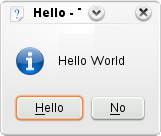Development/Tutorials/First program: Difference between revisions
→Build: why should a simple kde4 application link explicitely to dl?! |
→Abstract: Add tip to use kdevelop and link to that page |
||
| Line 15: | Line 15: | ||
Your first program shall greet the world with a friendly "Hello World", what else? For that, we will use a {{class|KMessageBox}} and customise one of the buttons. | Your first program shall greet the world with a friendly "Hello World", what else? For that, we will use a {{class|KMessageBox}} and customise one of the buttons. | ||
[[image:introtokdetutorial1.png|frame|center]] | [[image:introtokdetutorial1.png|frame|center]] | ||
{{tip|To get more information about any class you come across, Konqueror offers a quick shortcut. So to look for information about KMessageBox, just type "kde:kmessagebox" into Konqueror and you'll be taken to the documentation.}} | {{tip|To get more information about any class you come across, Konqueror offers a quick shortcut. So to look for information about KMessageBox, just type "kde:kmessagebox" into Konqueror and you'll be taken to the documentation.}} | ||
{{tip| | |||
You might want to use KDevelop for your projects, which does many nice things like code completition, easy access to API documentation or debugging support. | |||
Read [[Getting_Started/Set_up_KDE_4_for_development#KDevelop|this tutorial]] to set up KDevelop correctly for this task. You probably want to check if the setup is working by testing opening an existing KDE 4 application with KDevelop first. | |||
You still need to edit the CMake files by hand though. | |||
}} | |||
==The Code== | ==The Code== | ||
Revision as of 12:06, 13 April 2007
| Tutorial Series | Beginner Tutorial |
| Previous | C++, Qt, KDE4 development environment |
| What's Next | Tutorial 2 - KMainWindow |
| Further Reading | CMake |
Abstract
Your first program shall greet the world with a friendly "Hello World", what else? For that, we will use a KMessageBox and customise one of the buttons.



Read this tutorial to set up KDevelop correctly for this task. You probably want to check if the setup is working by testing opening an existing KDE 4 application with KDevelop first.
You still need to edit the CMake files by hand though.
The Code
All the code we need will be in one file, main.cpp. Create that file with the code below:
- include <QString>
- include <KApplication>
- include <KAboutData>
- include <KMessageBox>
- include <KCmdLineArgs>
int main (int argc, char *argv[])
{
KAboutData aboutData( "tutorial1", "Tutorial 1",
"1.0", "KMessageBox popup",
KAboutData::License_GPL, "(c) 2006" );
KCmdLineArgs::init( argc, argv, &aboutData );
KApplication app;
KGuiItem guiItem( QString( "Hello" ), QString(),
QString( "this is a tooltip" ),
QString( "this is a whatsthis" ) );
KMessageBox::questionYesNo( 0, "Hello World",
"Hello", guiItem );
}
The first KDE specific code we come across in this program is KAboutData. This is the class used to store information about the program such as a short description, authors or license information. Pretty much every KDE application should use this class.
Then we come to KCmdLineArgs. This is the class one would use to specify command line switches to, for example, open the program with a specific file. However, in this tutorial, we simply initialise it with the KAboutData object we created so we can use the --version or --author switches.
On line 13 we create a KApplication object. This needs to be done exactly once in each program since it is needed for things such as i18n.
Now we've done all the necessary KDE setup, we can move on to doing interesting things with our application. We're going to create a popup box but we're going to customise one of the buttons. To do this customisation, we need to use a KGuiItem object. The first argument in the KGuiItem constructor is the text that will appear on the item (in our case, a button). Then we have an option of setting an icon for the button but we don't want one so we just give it QString(). Finally we set the tooltip (what appears when you hover over an item) and finally the "What's This?" (accessed through right-clicking or Shift-F1) text.
Now we have our item, we can create our popup. we call the KMessageBox::questionYesNo() function which, by default, creates a message box with a "Yes" and a "No" button. The second argument is the text that will appear in the middle of the popup box. The third is the caption the window will have and finally we set the KGuiItem for (what would normally be) the "Yes" button to the KGuiItem guiItem we created.
We're all done as far as the code is concerned. Now to build it and try it out.
Build
If you set up your environment as described in Getting_Started/Build/Unstable_Version, you can compile this code with
gcc main.cpp -o tutorial1 \ -I/home/kde-devel/qt-copy/include/Qt \ -I/home/kde-devel/qt-copy/include/QtCore \ -I/home/kde-devel/qt-copy/include \ -I/home/kde-devel/kde/include/KDE \ -I/home/kde-devel/kde/include \ -L/home/kde-devel/kde/lib \ -L/home/kde-devel/qt-copy/lib -lQtCore -lQtGui -lkdeui -lkdecore
and then run it with
dbus-launch ./tutorial1
Using CMake
If that worked, you may want to use CMake, just like the rest of KDE.
CMakeLists.txt
Create a file named CMakeLists.txt in the same directory as main.cpp with this content:
project (tutorial1)
find_package(KDE4 REQUIRED)
include_directories( ${KDE4_INCLUDES} )
set(tutorial1_SRCS main.cpp)
kde4_add_executable(tutorial1 ${tutorial1_SRCS})
target_link_libraries(tutorial1 ${KDE4_KDEUI_LIBS})
Make And Run
Then it's simply a case of doing (from the directory where main.cpp is)
cmake . make dbus-launch ./tutorial1
Moving On
Now you can move on to using KMainWindow.
